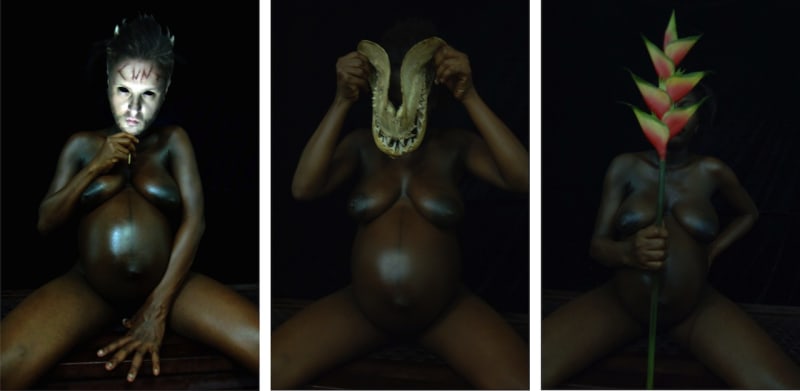From March 17 to 18, 2011, Temple Productions of Nigeria and M Contemporary Art of Italy will present Crosscurrents, at the Civic Centre, Victoria Island. The exhibition is curated by Oliver Enwonwu and co-curated by Bethabel Soetan, both of Omenka Gallery, and M Contemporary Art’s Marta Boeri and Marinu Paduano.
Among the artists of the exhibition are: Peju Alatise, Matteo Basile, Angelo Bellobono, Filippo Centenari, Francesco Cervelli, Uche Edochie, Oliver Enwonwu, Alberto Di Fabio, Stefania Fabrizi, Omar Galliano, Jonathan Guitamacchi, Rom Isichei, Uche James–Iroha, Chidi Kwubiri, Adriano Nardi, Alex Nwokolo, Abiodun Olaku, Kolade Oshinowo, Davide Eron Salvadei and Mudi Yahaya.
The exhibition offers a broad view of the multiplicity and diversity of contemporary Nigerian and Italian art. Through the work of 20 leading and exciting artists, working in various media including digital prints and photography, the exhibition addresses the relationship between personal identity, self-discovery and history from different perceptions while charting the evolution of contemporary art in both cultures.
In juxtaposing artworks by Nigerian and Italian contemporary artists, we collectively examine the varying styles, techniques and philosophies employed by the artists to address issues of belonging and identity. Though these may be universal concepts, the complexities of nationality, history and ethnicity offer greatly differing perspectives.
Indeed, Nigeria is a melting pot of incredible literary, artistic and musical talents. The rich, cultural heritage of the country stems from the multitude of ethnic groups and spoken languages. Like most great nations, Nigeria’s history is also peppered with traumatic events. Since gaining independence in 1960, Nigeria has suffered a horrific civil war, an oil boom and several corrupt leaders, and continues to struggle to recover from economic meltdowns.
Inevitably past and current events and experiences form part of one’s identity, a concept that applies universally. Unfortunately, the preservation of one’s identity by African artists only encouraged Western art critics to cast modern African art within primitive frameworks. Ben Enwonwu MBE (1917-1994), arguably Africa’s greatest and most influential contemporary artist of the 20th century, spent most of his life challenging these assertions. However, unlike the majority of contemporary African artists at the time, Enwonwu enjoyed enormous international acclaim. As a pivotal figure in the Nationalist movement in Nigeria, he employed culturally-inspired motifs from several Nigerian ethnic groups to forge a visual language for modern Nigerian art.
Enwonwu provided a creative context within which many important Nigerian artists defined themselves in the colonial and post-colonial periods. The pioneering efforts of Ben Enwonwu set the stage for an immense identity struggle, culminating in ‘the rebellion’ at the famous Zaria Art School established in 1959 by about 10 leading members of the, then newly formed Zaria Art Society. This group included distinguished artists like Bruce Onobrakpeya, Yusuf Grillo, Demas Nwoko and Uche Okeke, who were insistent on reconnecting to their roots and rejecting the total embrace of Western art traditions. They sought to redefine the practice of art in their institution and in Nigeria by fusing traditional Nigerian folklore and classical Nigerian art, including the Nok, Igbo-Ukwu, Ife and Benin with modern art techniques and philosophies.
Nigerian contemporary art continues to be influenced by classical Nigerian art and at the same time, often fuses ideologies with Western concepts thus creating a unique contemporary Nigerian visual vocabulary. Similarly, Italian contemporary art continues to draw inspiration from Italian history and tradition, the Renaissance and the numerous art movements which took place in Italy until now. The exhibition seeks to emphasize the similarities between the two cultures while highlighting the individuality of each work. Here an attempt is made to showcase the progression of Nigerian and Italian contemporary art through these powerful and thought-provoking works, some of which include social, political and pop-culture references.
Works such as Forest Whispers and Divine Revelation by master artist, Kolade Oshinowo immediately draw us into a pluralistic African society, where an enchanted forest inhabited by the spirits of our ancestry co-exist in a world where supplications and reverence to our Creator are the order of the day. This belief in the supernatural is mirrored by Matteo Basilé’s mystical universe. His work interrogates the boundaries of the complexities between art and technology. His haunting images portray derailed characters searching for acceptance in a more conventional world. The experimentation with diverse media is also cleverly illustrated by the amalgamation of traditional and contemporary digital techniques as portrayed in Adriano Nardi’s works Lo Specchio Di Diana and Tempi Di Diana.
Photographer, Mudi Yahaya’s Black Woman 'Unplugged' series confronts the Western constraints and stereotypes suffocating black women today and their desire to be liberated. Uche James-Iroha’s body of work titled Workshop gives the audience a revitalizing view of the ‘everyday’ man at work in Nigeria. His portrait, Made in England, succinctly addresses the brutal relationship between the colonizer and colonized and the effects of post-colonialism on the national psyche. In Framed, Oliver Enwonwu employs a vigorous palette and brushwork to capture a transitory and solitary moment in the life of the African man and his personal desire for success and recognition. He emphasizes on the beautiful, strong and proud features of the African man-an image rarely seen in society; instead, we are often confronted with portrayals of African men as dishonest and desperate.
Peju Alatise’s art is strongly evocative of the 60s pop culture movement. Contrastingly, Angelo Bellabono’s male portraits possess stark, yet subtle and soft qualities, betraying the state of helplessness and emptiness of his characters. In Reclamation, Abiodun Olaku champions the peoples’ yearning to be free from oppression and corrupt leadership, while Jonathan Guaitamacchi is concerned with the effects of an increasingly urbanised world on our physical bodies.
Overall, the exhibition has a strong contemporary outlook and fascinating power to pull together the cultural threads that tie a distant past to the fast-paced transformations of the present. It also puts into play a discourse that is based not on formal elements-cold concepts and stylistic disguises, but on experiences and knowledge.
